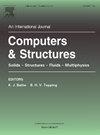Three-dimensional train-periodic slab track-subgrade dynamics model based on the iterative solution and Green’s function method
IF 4.8
2区 工程技术
Q1 COMPUTER SCIENCE, INTERDISCIPLINARY APPLICATIONS
引用次数: 0
Abstract
This paper develops an iterative solution model for the efficient and accurate simulation of the dynamics of a three-dimensional (3D) train-periodic slab track-subgrade (TPSTS) system. The entire system is divided into the train-rail subsystem and the periodic slab-subgrade subsystem. An ordinary differential equation (ODE) model of the train-rail system is established, and a step-moving strategy is employed to enhance the computational efficiency. A frequency-domain Green’s function method (GFM) model is employed for modelling the periodic slab-subgrade. Considering the periodicity, symmetry, and attenuation characteristics of the track structure, the Green’s function of the slab-subgrade structure is obtained by conducting harmonic response analysis on a finite element model (FEM) of a quarter slab-subgrade structure. The proposed model is utilized to investigate the vibration characteristics of the high-speed train-track-subgrade system. The results indicate that the model exhibits good convergence, accuracy, and efficiency. The periodicity of the track structure has a significant impact on the statistical values of subgrade displacement and stress amplitudes along the track’s longitudinal direction. At the subgrade surface, the amplitudes of displacement, stress, and acceleration exhibit fluctuations in the lateral direction of the track. However, with increasing depth, these amplitudes generally attenuate, leading to a more uniform distribution.
基于迭代解和格林函数法的三维列车-周期板轨道-路基动力学模型
本文建立了一个迭代求解模型,用于高效准确地模拟三维列车-周期板轨道-路基系统的动力学。整个系统分为列车-轨道子系统和周期板-路基子系统。建立了列车-轨道系统的常微分方程(ODE)模型,采用步进移动策略提高了计算效率。采用频域格林函数法(GFM)模型对周期性板-路基进行建模。考虑轨道结构的周期性、对称性和衰减特性,通过对1 / 4板-路基结构有限元模型进行谐波响应分析,得到板-路基结构的格林函数。利用该模型对高速列车-轨道-路基系统的振动特性进行了研究。结果表明,该模型具有良好的收敛性、准确性和效率。轨道结构的周期性对路基沿轨道纵向位移和应力幅值的统计值有显著影响。在路基表面,位移、应力和加速度的幅值在轨道的横向方向上呈现波动。然而,随着深度的增加,这些振幅通常会衰减,从而导致更均匀的分布。
本文章由计算机程序翻译,如有差异,请以英文原文为准。
求助全文
约1分钟内获得全文
求助全文
来源期刊

Computers & Structures
工程技术-工程:土木
CiteScore
8.80
自引率
6.40%
发文量
122
审稿时长
33 days
期刊介绍:
Computers & Structures publishes advances in the development and use of computational methods for the solution of problems in engineering and the sciences. The range of appropriate contributions is wide, and includes papers on establishing appropriate mathematical models and their numerical solution in all areas of mechanics. The journal also includes articles that present a substantial review of a field in the topics of the journal.
 求助内容:
求助内容: 应助结果提醒方式:
应助结果提醒方式:


